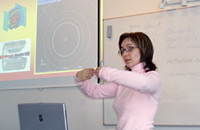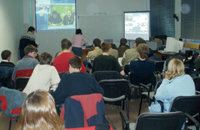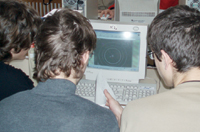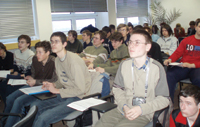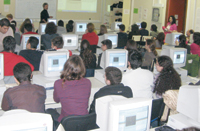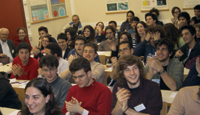Looking for leptons in all the right places
by Jennifer Lauren Lee
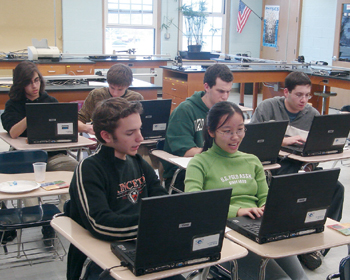 |
|
Above: Tania Entwistle's team of students from Ward Melville High School in New York. Front from left: Stephen Bohlman, Sammi Qin. Back from left: Ram Gupta, Lucas Janson, Ari Richman, Josh Steinberg. Below: Students around the world participate in videoconferences, lectures, and analysis of particle physics data. Photos: Ken Cecire, Hampton University; Ivan Melo, ilinská universite, Slovakia; and Christine Kourkoumelis, University of Athens, Greece |
In a typical high school physics textbook, says scienceeducation specialist Beth Marchant, only the last chapter is devoted to all the developments since 1900–the stuff that physicists are actually working on today. "For teachers who go by the textbook," says Marchant, "the class never gets there."
Marchant is part of a multinational team, from programs in Europe and the United States, collaborating to transform the way physics is taught. They offer kids the chance to close their textbooks and experience modern science first-hand.
A program organized and run by Michael Kobel of the Technical University in Dresden, Germany, gives 16- to 18-year-old students the chance to be "physicists for a day," teaching them to identify subatomic particles from real data collected by detectors at the European laboratory CERN. The European Particle Physics Outreach Group supports Kobel's EPPOG "Masterclass."
Based on a smaller-scale program in the United Kingdom, Kobel's Masterclasses include 60 institutions from 18 countries and a total of 3000 students, all analyzing the same sets of data. The students gather at local institutions for one intensive day, with lectures from scientists on performing measurements with particle detectors. At the end of the day, all join in a videoconference to share and discuss their results, just as physicists would at one of their own conferences.
"You can talk about this kind of thing in the classroom, but when you're actually sitting beside a kid from Greece who's asking the same question, that's a different thing," says Ken Cecire. Along with Marchant, Cecire is working to invigorate US high-school physics through QuarkNet, supported by the National Science Foundation and the Department of Energy's Office of Science. QuarkNet centers are connected to high-energy-physics experiments at CERN, Fermilab, SLAC, and other research institutions.
QuarkNet has established centers at 51 universities and laboratories, reaching teachers at 475 US high schools and involving some 60,000 students each year. Students analyze live, online data provided by particle detectors in the United States; and teachers join research teams, with physicists at a local university or laboratory as mentors. Marchant works at the University of Notre Dame; Cecire at Hampton University.
|
|
QuarkNet became involved in the EPPOG Masterclass this year when Silvia Schuh and Dave Barney, CERN physicists who help run the Masterclasses, independently invited QuarkNet to include American students.
For two weeks, three CERN physicists took turns as moderators, guiding two to three hundred students from half a dozen countries through the process of sharing their results–in English. "Some days it's fantastic, some days it's very hard work," Barney says. He describes cajoling silent students into asking him questions, but also interacting with students who are laughing, questioning, and doing the "wave." The students participate in the program for one long, intense day with the videoconference late in the afternoon. The schedule created what Barney calls a "logistics nightmare" for the Americans, who had to split their event into two half-days, analyzing data one day and conferencing the next morning.
Student Stephen Bohlman, from Ward Melville High School in New York, heard about the EPPOG Masterclass program when another teacher–Tania Entwistle, an active QuarkNet participant–came into his Advanced Placement (AP) Physics class and asked for volunteers. "It's stuff that interests me," says Bohlman, 16. "I find it fascinating–all the leptons, bosons, hadrons–oh my!"
In the weeks before their conference date, Entwistle's six students used the online preparation guide created by Kobel, with a downloadable CD-ROM (available in 16 languages), to learn how to identify particles based on their "tracks"–the trails left in a particle detector following matter-antimatter collisions. "For many students, antimatter is a kind of science fiction that they have heard from Star Trek and Angels and Demons," says Kobel, "but they are not aware that we work with antimatter each day." Helio Takai, a physicist at Brookhaven National Laboratory and a mentor for high-school physics teachers in QuarkNet, spent a few afternoons offering background in the Standard Model–a topic not usually covered in the highschool curriculum. Then they set the kids loose on the data.
Entwistle describes her students, working in pairs, teaching themselves the rules of classification by looking at the event displays. "I was amazed because they would sit there and argue about it, and come up with a synthesis," Entwistle says. Physicists don't usually analyze the data by hand like this, the students were told, but scientists need to be able to recognize the events if the computer algorithm fails to distinguish them.
Ward Melville junior Sammi Qin says she had no special love for physics; she just thought the program sounded cool. "We could do something with this data. It made us feel that we were scientists for a day, or a week in our case," Qin says. She and Bohlman, her partner, especially enjoyed spotting the muon and electron decays, relatively rare but easily identifiable. "When we saw one, we'd just scream out, 'The muon!'" Qin says. "Once we got the hang of it, I think I got even more excited because we actually knew what we were doing. That was an exhilarating experience." Bohlman agrees: "It was really hard at first. We just looked at the computer screen and there were a bunch of colorful lines, and we had no idea what to do. Then it got easier [and] we could tell within two seconds once we got used to it."
Entwistle's students learned what it is like to break new ground in science, relying on collaboration and the answers of your colleagues to check your work. "You come away with a deeper appreciation for what scientists do–how they collaborate with each other," Bohlman says. "Scientists aren't the classic Back to the Future scientist with the white lab coat and the crazy gray hair."
Funds permitting, another Masterclass series is planned for 2007. Barney wants students to ask questions about everything, from life at CERN to how the universe began. It's part of the quest to have them think of science as "a bigger thing than just a textbook and worksheets and labs," Marchant says. "It's a living thing."
Click here to download the pdf version of this article.



